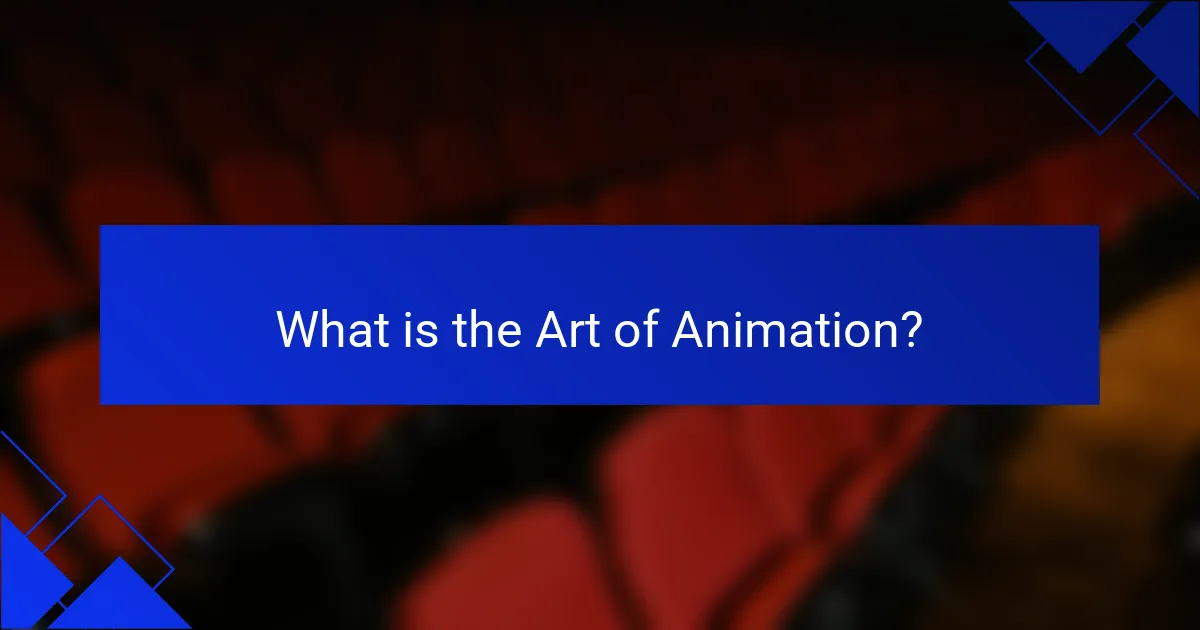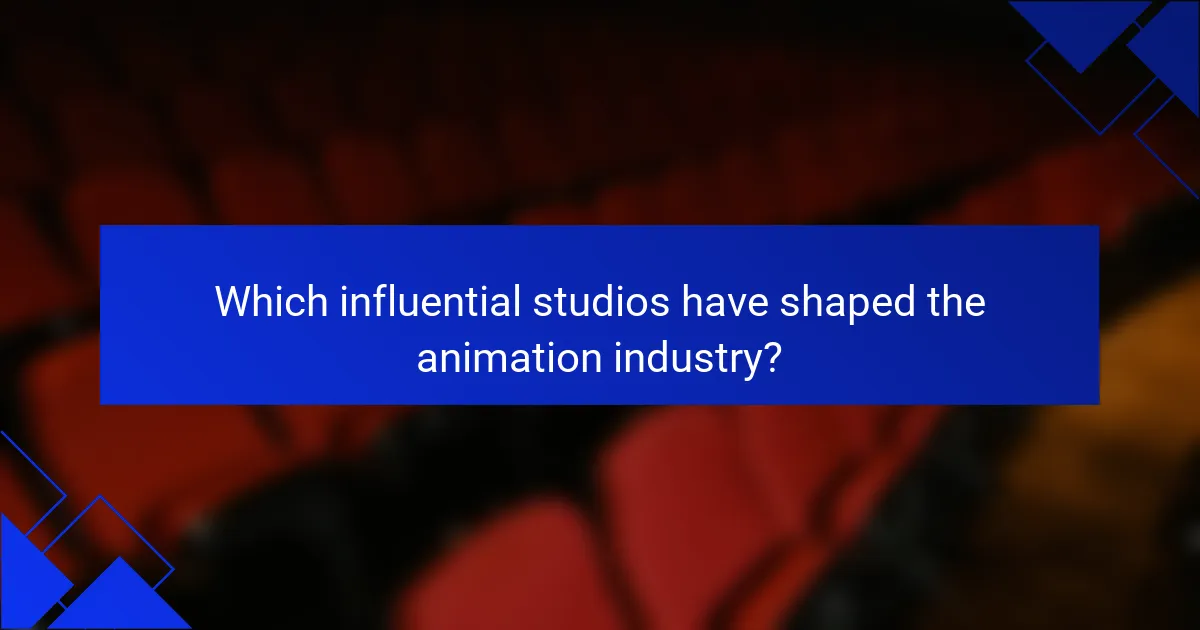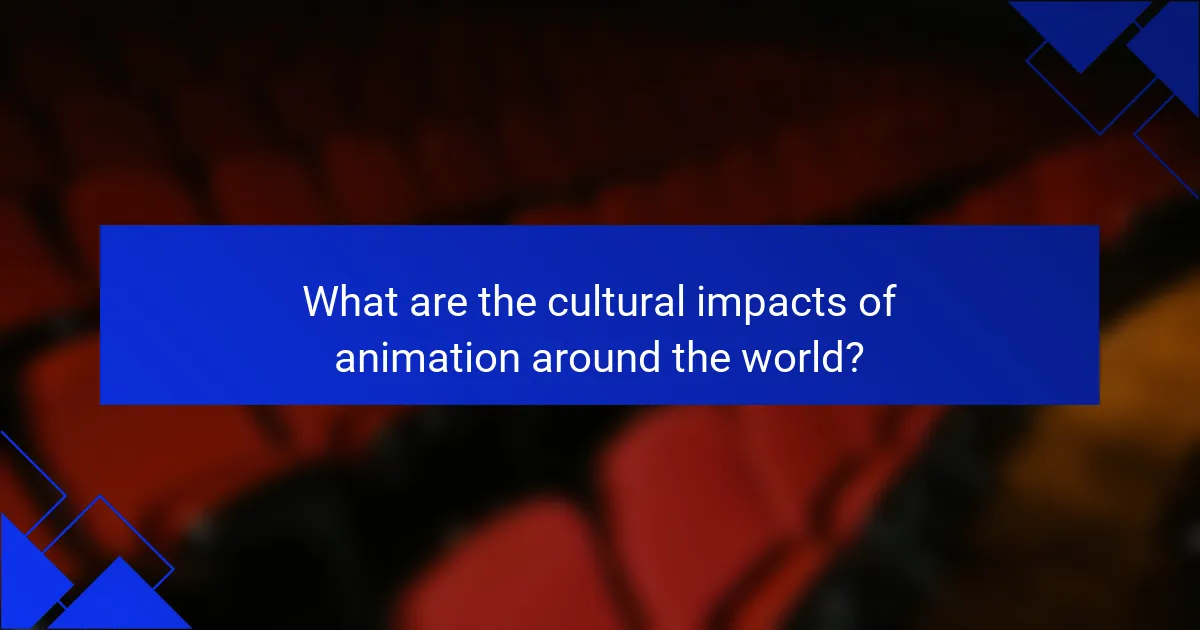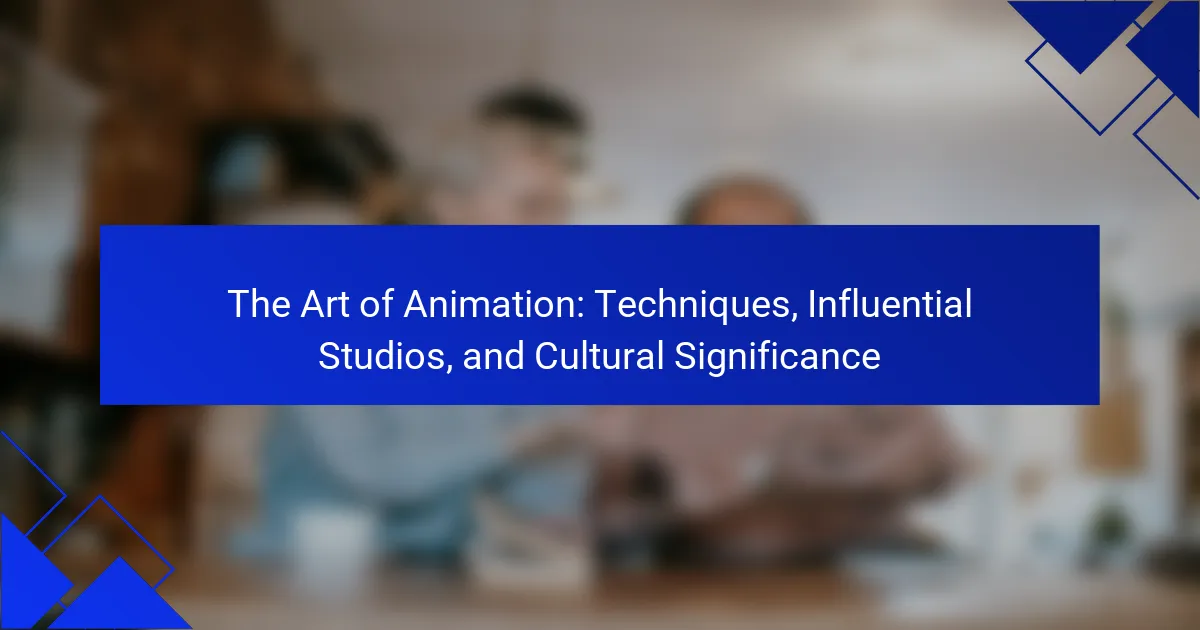
What is the Art of Animation?
The Art of Animation is the process of creating moving images through various techniques. It combines artistry and technology to bring characters and stories to life. Traditional animation involves hand-drawn images, while digital animation uses software to create visuals. Both methods require a deep understanding of motion, timing, and storytelling. Animation has evolved significantly since its inception in the late 19th century. Influential studios like Disney and Pixar have shaped the industry with innovative techniques. The art form has cultural significance, influencing visual storytelling across media. Animation is not just for entertainment; it also serves educational and artistic purposes.
How did the art of animation evolve over time?
The art of animation evolved through several key phases. It began with early techniques like shadow puppetry and stop-motion in the 19th century. The invention of the cel technique in the 1910s revolutionized animation production. This allowed for more fluid movement and detailed backgrounds. The introduction of synchronized sound in the 1920s, exemplified by Disney’s “Steamboat Willie,” transformed storytelling in animation.
The 1930s saw the emergence of feature-length animated films, with “Snow White and the Seven Dwarfs” setting a benchmark. The mid-20th century introduced television animation, expanding the medium’s reach. The 1990s brought computer-generated imagery (CGI), culminating in films like “Toy Story.” Today, animation continues to evolve with advancements in technology, including virtual reality and interactive experiences. Each phase reflects changing artistic techniques and cultural contexts in animation’s history.
What are the key milestones in the history of animation?
The key milestones in the history of animation include the invention of the phenakistoscope in 1832. This device created the illusion of motion through a series of images. In 1908, “Gertie the Dinosaur” became one of the first animated films featuring a character. Walt Disney’s “Steamboat Willie,” released in 1928, was the first synchronized sound cartoon. The introduction of Technicolor in 1932 revolutionized animation with vibrant colors. In 1937, Disney released “Snow White and the Seven Dwarfs,” the first full-length animated feature. The 1995 release of “Toy Story” marked the first entirely computer-generated animated film. These milestones shaped the evolution of animation as an art form.
How have technological advancements influenced animation techniques?
Technological advancements have significantly influenced animation techniques by enhancing the tools and processes used in animation creation. The introduction of computer-generated imagery (CGI) revolutionized traditional animation methods. Techniques like 3D modeling and rendering allow for more realistic visual effects. Software such as Maya and Blender has streamlined the animation workflow. Motion capture technology has enabled animators to create lifelike character movements. Additionally, advancements in graphics processing units (GPUs) have improved rendering speeds and quality. These innovations have expanded creative possibilities for animators. Films like Pixar’s “Toy Story” exemplify the impact of technology on animation.
What are the fundamental techniques used in animation?
The fundamental techniques used in animation include traditional hand-drawn animation, stop motion, and computer-generated imagery (CGI). Traditional hand-drawn animation involves creating individual frames by drawing characters and scenes by hand. This technique has been used since the early 20th century in classic films like “Snow White and the Seven Dwarfs.” Stop motion animation uses physical models and captures them frame by frame to create movement. Notable examples include “The Nightmare Before Christmas.” Computer-generated imagery (CGI) involves creating animations using digital tools and software, revolutionizing the field with films like “Toy Story.” Each technique has unique attributes and historical significance in the evolution of animation.
What is traditional animation and how does it differ from digital animation?
Traditional animation is a technique where each frame is hand-drawn or painted. This method involves creating a series of individual images that, when sequenced, create the illusion of movement. The process is labor-intensive and often requires a team of artists.
In contrast, digital animation utilizes computer software to create images and sequences. This method allows for greater flexibility and efficiency, enabling artists to manipulate images easily. Digital animation often incorporates 3D modeling, which is not present in traditional animation.
The main difference lies in the creation process. Traditional animation relies on physical materials, while digital animation uses digital tools. Each method has its unique aesthetic and appeal. Traditional animation is often praised for its artistry and craftsmanship. Digital animation is recognized for its versatility and speed.
How do stop-motion and 3D animation techniques work?
Stop-motion animation involves capturing individual frames of physical objects in slight incremental movements. Each frame is photographed and played in sequence to create the illusion of motion. Common materials include clay, puppets, and everyday objects. This technique dates back to the late 19th century, with notable examples like “The Adventures of Prince Achmed” (1926).
3D animation, on the other hand, utilizes computer-generated imagery (CGI) to create three-dimensional models. Artists design and manipulate these models within a digital environment. The process involves rigging, where a skeletal structure is created for the model, followed by animation, where movements are programmed. This technique gained prominence in the 1990s, with landmark films like “Toy Story” (1995) showcasing its capabilities.
Both techniques rely on frame-by-frame progression to convey fluid motion, but they differ in their execution and materials. Stop-motion uses tangible objects, while 3D animation relies on digital tools and software.
Why is animation considered an important art form?
Animation is considered an important art form because it combines creativity, storytelling, and technology. This medium allows artists to express complex ideas visually. Animation engages audiences through movement and sound, enhancing emotional impact. Historical milestones, such as Walt Disney’s “Snow White,” established animation’s cultural significance. It has evolved into various styles, including 2D, 3D, and stop-motion. Animation influences other art forms, including film and video games. The global animation industry generates billions in revenue, reflecting its economic importance. This art form continues to innovate, pushing boundaries in visual storytelling.
How does animation impact storytelling and audience engagement?
Animation enhances storytelling by providing visual dynamism and emotional depth. It allows for imaginative worlds and characters that can captivate audiences. The use of color, movement, and style in animation can evoke specific emotions. Studies show that animated content often leads to higher viewer retention rates. For example, a report by Nielsen found that animated shows can attract a younger audience effectively. Animation also enables complex narratives to be simplified for broader understanding. This accessibility fosters greater audience engagement. The unique visual language of animation can make abstract concepts more relatable.
What cultural significance does animation hold in different societies?
Animation holds significant cultural value across various societies. It serves as a medium for storytelling, reflecting cultural narratives and traditions. In Japan, anime conveys deep-rooted themes and societal issues, influencing global pop culture. In Western societies, animation often addresses humor and family values, shaping perceptions and social norms. Indigenous cultures utilize animation to preserve and share folklore, enhancing cultural identity. Educational animations promote awareness of social issues, aiding in cultural understanding. Animation also fosters community engagement through festivals and screenings, uniting diverse audiences. The global reach of animation allows for cross-cultural exchange, enriching artistic expression and understanding.

Which influential studios have shaped the animation industry?
Walt Disney Animation Studios, Pixar Animation Studios, and Studio Ghibli are influential studios that have shaped the animation industry. Walt Disney Animation Studios pioneered feature-length animated films, starting with “Snow White and the Seven Dwarfs” in 1937. This studio introduced innovations in storytelling and character development. Pixar Animation Studios revolutionized animation with its use of computer-generated imagery, debuting with “Toy Story” in 1995. This studio is known for its emotional storytelling and technical advancements. Studio Ghibli, founded by Hayao Miyazaki, is renowned for its artistic style and deep narratives. Films like “Spirited Away” have won international acclaim, influencing global animation trends.
What are the most notable animation studios and their contributions?
Walt Disney Animation Studios is a leading animation studio known for its classic animated films. It contributed iconic works such as “Snow White and the Seven Dwarfs” and “The Lion King.” Pixar Animation Studios revolutionized 3D animation with films like “Toy Story” and “Finding Nemo.” Studio Ghibli is renowned for its hand-drawn animation and storytelling, with films like “Spirited Away.” DreamWorks Animation gained fame with franchises like “Shrek” and “Kung Fu Panda.” Laika is recognized for its stop-motion animation, particularly in “Coraline” and “Kubo and the Two Strings.” Each studio has significantly influenced the animation industry and culture.
How did Walt Disney Animation Studios revolutionize the animation landscape?
Walt Disney Animation Studios revolutionized the animation landscape by introducing synchronized sound in animated films. This innovation was first showcased in “Steamboat Willie” in 1928. It set a new standard for the industry, blending audio and visual storytelling. The studio also pioneered the use of Technicolor in animation with “Flowers and Trees” in 1932. This film won the first Academy Award for Animated Short Film. Additionally, Disney’s storytelling techniques emphasized character development and emotional depth. The studio’s feature-length film “Snow White and the Seven Dwarfs” in 1937 established animation as a viable medium for full-length storytelling. Disney’s advancements in animation technology, such as the multiplane camera, further enhanced visual depth and realism. These innovations collectively transformed animation into a respected art form and influenced countless filmmakers.
What role did Pixar play in advancing animation technology and storytelling?
Pixar played a pivotal role in advancing animation technology and storytelling. The studio revolutionized computer-generated imagery (CGI) with the release of “Toy Story” in 1995, the first feature-length film entirely created using CGI. This technological leap set new standards for animation quality and visual storytelling. Pixar’s proprietary software, RenderMan, became a benchmark for rendering high-quality images in the industry.
Additionally, Pixar’s narrative approach emphasized character-driven stories and emotional depth. Films like “Finding Nemo” and “Up” showcased complex themes and innovative storytelling techniques. The studio’s commitment to storytelling excellence earned numerous Academy Awards, further solidifying its influence in animation. Pixar’s combination of cutting-edge technology and compelling narratives has reshaped the landscape of animated films.
How do independent studios contribute to the animation scene?
Independent studios contribute to the animation scene by fostering creativity and innovation. They often produce unique and diverse content that mainstream studios may overlook. Independent studios allow for artistic experimentation, leading to new techniques and storytelling methods. For instance, films like “The Secret of Kells” showcase distinct visual styles and cultural narratives. They also provide a platform for emerging talent in animation. Many renowned animators began their careers in independent studios, such as Laika and Studio Ghibli. Overall, independent studios enrich the animation landscape with varied perspectives and artistic expressions.
What unique styles or narratives do independent animators bring to the industry?
Independent animators bring diverse styles and narratives that often challenge mainstream conventions. They frequently utilize experimental techniques, such as stop-motion and hand-drawn animation. This results in a distinct visual aesthetic that emphasizes artistry over commercial appeal. Independent narratives often explore personal, cultural, or social themes that resonate on a deeper emotional level. For instance, films like “The Secret of Kells” showcase unique storytelling rooted in folklore and mythology. These works often prioritize artistic expression and innovation, setting them apart from larger studio productions. Independent animators also tend to embrace unconventional character designs and storytelling structures. This flexibility allows for greater creative freedom and a wider range of subject matter. The impact of these unique contributions is evident in the growing recognition of independent films at major animation festivals.
How has the rise of streaming services affected independent animation studios?
The rise of streaming services has significantly impacted independent animation studios. Streaming platforms have created new opportunities for distribution. Independent studios can now reach wider audiences without traditional gatekeepers. This has led to increased visibility for diverse and unique animated content. For instance, platforms like Netflix and Hulu have invested in original animated series. This investment provides funding and resources that independent studios previously lacked. Additionally, streaming services often prioritize niche content, benefiting smaller studios. As a result, independent animation has gained more creative freedom and financial support.

What are the cultural impacts of animation around the world?
Animation significantly influences cultures worldwide. It serves as a medium for storytelling and cultural expression. Different countries use animation to reflect their unique traditions and values. For example, Japanese anime often incorporates themes of honor and community. In contrast, Western animation may focus on individualism and humor. Animation also promotes cultural exchange by introducing audiences to diverse perspectives. It can challenge stereotypes and foster understanding among different cultures. Furthermore, animated films often address social issues, raising awareness and inspiring change. The global animation industry generates billions in revenue, showcasing its economic and cultural importance.
How does animation reflect cultural values and social issues?
Animation reflects cultural values and social issues by portraying societal norms and challenges. It serves as a mirror to the beliefs and practices of a society. For example, films like “Zootopia” address themes of prejudice and acceptance. Similarly, “Coco” explores family values and cultural heritage. Animation often highlights issues such as gender roles, environmental concerns, and mental health. These themes resonate with audiences and provoke thought. Historical contexts influence animated narratives, shaping their messages. Research shows that animation can foster empathy and understanding across cultures. This demonstrates the medium’s power to influence perceptions and inspire change.
What are examples of animated works that address significant cultural themes?
Examples of animated works that address significant cultural themes include “Coco,” “Zootopia,” and “Spirited Away.” “Coco” explores themes of family and the Mexican tradition of Día de los Muertos. It highlights the importance of remembering ancestors and cultural heritage. “Zootopia” tackles issues of prejudice and discrimination through a story about a diverse animal society. It reflects real-world social dynamics and challenges stereotypes. “Spirited Away” delves into themes of consumerism and environmentalism within Japanese culture. It portrays a young girl’s journey in a spirit world, emphasizing the value of nature and identity. These films illustrate how animation can convey deep cultural messages.
How do different cultures approach animation styles and storytelling?
Different cultures approach animation styles and storytelling through unique techniques and themes. For example, Japanese animation, or anime, often emphasizes emotional depth and complex narratives. In contrast, Western animation typically focuses on humor and family-friendly content.
Cultural influences shape these styles significantly. In India, animation often incorporates traditional art forms and folklore, creating a distinct visual and narrative style. African animation frequently reflects local stories and social issues, using vibrant colors and rhythmic storytelling.
The cultural context also affects character design and themes. For instance, European animations may explore existential themes, while Middle Eastern animations often highlight community and family values.
These diverse approaches contribute to the global animation landscape, showcasing a variety of artistic expressions and storytelling methods.
What role does animation play in education and social awareness?
Animation serves as a powerful tool in education and social awareness. It engages audiences through visual storytelling. This medium simplifies complex concepts, making learning more accessible. For instance, animated videos can illustrate scientific processes effectively. Animation also fosters empathy by depicting diverse perspectives. Educational platforms like Khan Academy utilize animation to enhance learning experiences. Research indicates that animated content increases retention rates among learners. A study by the University of California found that students remember 50% more information when presented with animated visuals. Thus, animation significantly contributes to both educational effectiveness and social consciousness.
How can animation be used as a tool for teaching complex subjects?
Animation can be used as a tool for teaching complex subjects by simplifying intricate concepts visually. It transforms abstract ideas into engaging visual narratives. This approach enhances understanding through dynamic representation. Research shows that visual learning improves retention by up to 65%. Animation captures attention and maintains interest, making learning enjoyable. Additionally, it allows for the demonstration of processes over time, such as scientific experiments or historical events. This sequential visualization aids in comprehending cause-and-effect relationships. Overall, animation serves as an effective educational medium by combining visual appeal with pedagogical effectiveness.
What are some successful campaigns that utilized animation for social change?
Successful campaigns that utilized animation for social change include “The Story of Stuff” and “Coca-Cola’s Happiness Factory.” “The Story of Stuff” uses animation to raise awareness about consumerism and environmental issues. It has garnered millions of views and sparked discussions on sustainability. “Coca-Cola’s Happiness Factory” campaign employed animation to promote positive social messages and community engagement. The campaign successfully reached global audiences, enhancing brand perception. These campaigns demonstrate the effectiveness of animation in conveying complex social messages in an engaging manner.
What are some best practices for aspiring animators?
Aspiring animators should focus on developing strong foundational skills. Mastering traditional drawing techniques enhances understanding of movement and anatomy. Learning software like Adobe Animate or Blender is essential for digital animation. Creating a diverse portfolio showcases versatility and style. Networking with industry professionals can lead to valuable opportunities. Seeking feedback from peers helps improve skills and creativity. Studying animation principles, such as timing and spacing, is crucial for effective storytelling. Lastly, staying updated on industry trends informs career development.
How can one develop a unique animation style?
To develop a unique animation style, one should explore various artistic influences and techniques. Experimenting with different mediums can lead to distinctive visual outcomes. Analyzing existing animation styles helps identify gaps and opportunities for innovation. Creating a personal artistic voice is essential for differentiation. Consistent practice and refinement of skills contribute to style development. Collaborating with other artists can introduce new perspectives and ideas. Gathering feedback from peers can enhance the evolution of one’s style. Documenting the creative process allows for reflection and growth in animation.
What resources are available for learning animation techniques?
Online platforms like Coursera and Udemy offer courses on animation techniques. These platforms provide structured learning paths and expert-led tutorials. Books such as “The Animator’s Survival Kit” by Richard Williams are essential resources. They cover fundamental principles and advanced techniques. YouTube channels like Cartooning Club How to Draw offer free tutorials. These resources cater to various skill levels, from beginners to advanced animators. Animation software like Adobe Animate and Blender have extensive documentation and tutorials available. These tools help learners practice and apply their skills effectively.
The Art of Animation is the process of creating moving images through various techniques, combining artistry and technology to bring characters and stories to life. This article explores the evolution of animation, key milestones in its history, and the influence of technological advancements on animation techniques. It also examines the contributions of influential studios like Walt Disney and Pixar, the significance of independent studios, and the cultural impact of animation across societies. Additionally, the article highlights the role of animation in education and social awareness, providing best practices for aspiring animators and resources for learning animation techniques.
